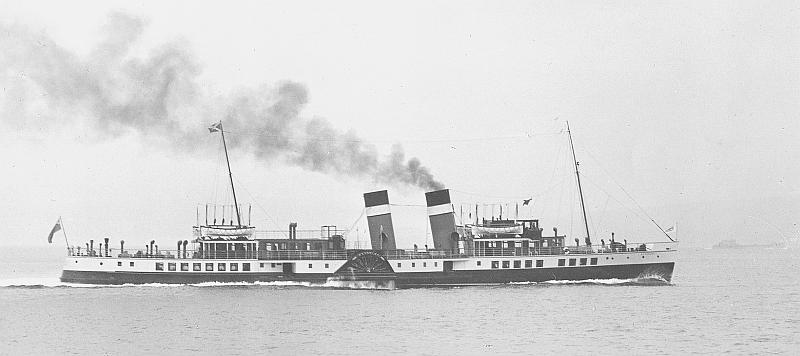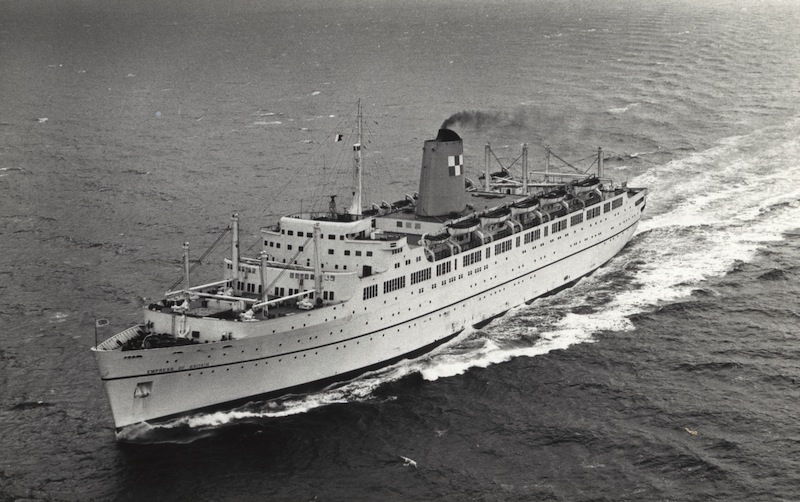
Antrim on the Skelmorlie Mile in 1904. Built by John Brown for the Midland Railway’s Heysham-Belfast service, she had triple expansion engines and ran at 21 knots — copyright photo CRSC/Andrew Clark Collection
Until the introduction of GPS-based sea trials nearly 20 years ago, the most precise way of measuring a ship’s speed was by following a course parallel to a measured mile on the land. Research carried out by Craig Osborne has established that no fewer than six measured miles were in use on the Clyde over the past 175 years. One of them, the Skelmorlie Mile, was recently revived for CalMac’s new ferry Catriona.
The first measured mile on the Clyde was the Gareloch Measured Mile, situated on the west shore of the loch opposite the naval base between the Meikle Burn near Barremman and the Mill Burn near Mamore. It was erected in 1841 to test T. Assheton Smith’s Fire King, which was contracted to Robert Napier, who supplied the machinery and sub-contracted the hull to the Portland Shipbuilding Company of Troon. The hull of this vessel was ribbed longitudinally. At Napier’s instigation the mile was re-built in 1861 by the Institution of Shipbuilders & Engineers in Scotland for the trials of the transatlantic paddle steamer Scotia, which subsequently won the Blue Riband. In 1886 William Denny, the Dumbarton shipbuilder, first used this mile for the paddle steamer Aurora. It later appeared as two half miles, with the eastern half mile split into quarter miles. The Gareloch mile was re-established by the British Ship Research Association with help from Denny for Lucy Ashton’s jet-propelled trials in 1952, when the posts were re-positioned to give better accuracy. McGruer, the Clynder yacht builder, took over the maintenance and insurance of the mile posts in January 1977, but the Gareloch mile fell into disuse in the 1980s.

Brighton, built by Denny in 1933 for the Southern Railway, achieved 24 knots on the Skelmorlie Mile — copyright CRSC/Andrew Clark Collection
The Skelmorlie Measured Mile was erected in August 1866 by Robert Napier. For the following 120 years this was the mile used to measure the speed of Clyde steamers and ferries, as well as cross-channel ships and occasionally larger vessels. In March 1920, for example, the 42,000-ton battlecruiser HMS Hood ran speed trials on the Skelmorlie mile as well as the Arran mile. The Skelmorlie mile was most recently used by Ferguson Marine Engineering during the speed trials of Catriona in July 2016.
The most internationally renowned of the Clyde’s speed trial miles was the Arran Measured Mile, built in 1916. Originally a single mile south of Sannox Rock, it was first used by the Fairfield-built 28,000-ton battlecruiser HMS Renown on 19 September 1916, when she attained 32 knots. It was later extended to two miles by erecting additional posts to the north. On 18 March 1920 HMS Hood attained 32 knots on this mile.
It was extended north again and the southern posts were removed in 1934 in order to accommodate the 68,000-ton Cunard liner Queen Mary, which attained 31 knots in April 1936. At the end of the Second World War a detachment of Polish soldiers was given the task of clearing the site and they cut down the posts — a fact discovered only when Britain’s last battleship, the 51,100-ton HMS Vanguard, began her trials. The posts were hastily re-erected and trials were re-run in July 1946, when Vanguard achieved 32 knots. The Arran mile belongs to the Admiralty. The decline of its usefulness for merchant shipping coincided with the late 20th century decline of the Clyde shipbuilding industry. Among the last commercially built vessels to undertake speed trials there were some Ailsa-built Polish cargo vessels and a gravel dredger in the early years of this century.
The Loch Long Measured Mile was established in 1940 by the Admiralty near Coulport, following the erection of the Cloch Boom. This mile enabled Clyde shipyards to continue carrying out speed trials for their ships during the war, and was especially useful for Robertson of Sandbank when they produced their motor torpedo boats (MTBs). The Loch Long mile was re-established by Yarrow Shipbuilders in 1959 as two half miles for the speed trials of their pusher tug Gongola with her train of eight barges. The Loch Long mile is no longer in existence.
The Ardmaleish Half Measured Mile, on the Bute shore of the East Kyle, was also erected by the Admiralty in 1940 to suit the MTBs being constructed there. This mile has also been removed.
The Parklea Measured Mile, east of Port Glasgow, was erected by the Denny Hovercraft Company in 1963 for testing their D1 hovercraft. This mile is no longer in existence.
Compiled by Craig Osborne.

One of the most famous ships to undergo trials on the Clyde was the battlecruiser HMS Hood, pictured on the Skelmorlie Mile in 1920. Built by John Brown at Clydebank, she ranked among the most powerful warships in the world, achieving legendary status when she was sunk by the German battleship Bismarck off Greenland in 1941, with the loss of all but three of her 1,418-crew. The Royal Navy exacted revenge three days later by sinking Bismarck — copyright photo University of Glasgow Archive Services, Adamson & Robertson Collection, GB 248 DC 101/2606, reproduced with permission

Waverley on the Skelmorlie Mile in 1947. There are conflicting accounts of the speed she achieved: some sources quote 17.15 knots, but Alan Brown, historian of the Craigendoran steamers, produced evidence stating she attained 18.37 knots — copyright photo CRSC/John Newth Collection

Cowal was a product of the Ailsa Shipbuilding and Engineering Company of Troon. She is pictured on the Skelmorlie Mile on 6 April 1954, when she reached a top speed of 15.54 knots — copyright CRSC/Lawrence Macduff Collection

Isle of Arran, built at Port Glasgow by Ferguson Ailsa Ltd, attained 15.9 knots on the Skelmorlie Mile on 4 April 1984 — copyright photo CRSC/Lawrence Macduff Collection

Catriona, CalMac’s latest ferry, underwent trials on the Clyde in August 2016, achieving a maximum GPS reading from the AIS of 11.4 knots. She is pictured during optimisation trials on the Largs-Cumbrae Slip crossing on August 17 — copyright photo CRSC/Andrew Clark
Published on 25 September 2016












